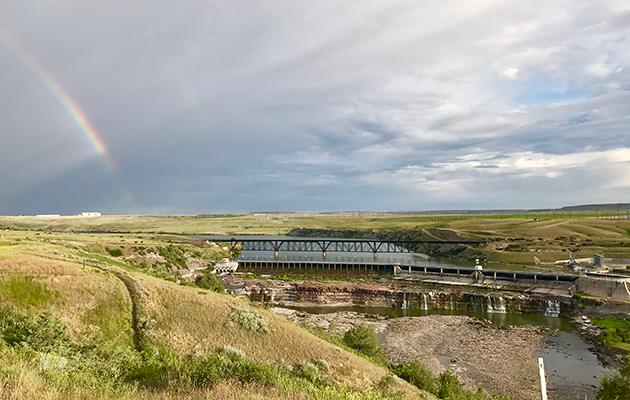
Rainbow
About the Rainbow Hydroelectric facility
Originally completed in 1910, Rainbow dam is located on the Missouri river, about 6 miles northeast of Great Falls, Montana. In 2013, a new, single-unit, 64-megawatt powerhouse replaced an eight-unit, 35-megawatt powerhouse, an upgrade that had been in place since 1918. This increased the hydroelectric facility's generating capacity by 70%.
As vital character in the early growth stages in the hydroelectric system, Rainbow had a number of important beneficiaries from its generated electricity. One of these being the short line Butte, Anaconda, and Pacific Railway, which became the nation's first freight railroad to be electrified, thanks to power produced at rainbow dam. Other notable beneficiaries include the electric trolleys in Butte, mines and smelters in Butte and Anaconda, and the Boston and Montana smelter reduction work in Black Eagle.
Historic Namesake

Historic Namesake
Previously known as "Handsome Falls," or "Cascade Falls," the second largest out of the five falls on the Missouri River were named in 1872 by Thomas Paschall Roberts. Roberts named the falls for the frequent rainbows that could be seen in their spray.
In 1805, these same falls proved to be a significant obstacle for the Lewis and Clark Expedition as they journeyed up the Missouri River. Despite this challenge, journals of the expedition notes the "agreeable sound of a fall of water."
Treasure of the Missouri

Treasure of the Missouri
"Golden Kilowatts: Water Power and the Early Growth of Montana"
Historic American Engineering Record (HAER) Documentation
Rainbow Hydroelectric Facilities:
- Rainbow Hydroelectric Facility, On north bank of Missouri River 2 miles Northeast of Great Falls, & end of Rainbow Dam Road, Great Falls, Cascade County, MT
- Rainbow Hydroelectric Facility, Foreman's House, On north bank of Missouri River 2 miles Northeast of Great Falls, & end of Rainbow Dam Road, Great Falls, Cascade County, MT
- Rainbow Hydroelectric Facility, Two Stall Garage, On north bank of Missouri River 2 miles Northeast of Great Falls, & end of Rainbow Dam Road, Great Falls, Cascade County, MT
- Rainbow Hydroelectric Facility, Three Stall Garage, On north bank of Missouri River 2 miles Northeast of Great Falls, & end of Rainbow Dam Road, Great Falls, Cascade County, MT
- Rainbow Hydroelectric Facility, Ten Stall Garage, On north bank of Missouri River 2 miles Northeast of Great Falls, & end of Rainbow Dam Road, Great Falls, Cascade County, MT
- Rainbow Hydroelectric Facility, House No. 16, On north bank of Missouri River 2 miles Northeast of Great Falls, & end of Rainbow Dam Road, Great Falls, Cascade County, MT
- Rainbow Hydroelectric Facility, Tool House, On north bank of Missouri River 2 miles Northeast of Great Falls, & end of Rainbow Dam Road, Great Falls, Cascade County, MT
- Rainbow Hydroelectric Facility, Clubhouse, On north bank of Missouri River 2 miles Northeast of Great Falls, & end of Rainbow Dam Road, Great Falls, Cascade County, MT
- Rainbow Hydroelectric Facility, Arbor, On north bank of Missouri River 2 miles Northeast of Great Falls, & end of Rainbow Dam Road, Great Falls, Cascade County, MT
- Rainbow Hydroelectric Facility, Fountain, On north bank of Missouri River 2 miles Northeast of Great Falls, & end of Rainbow Dam Road, Great Falls, Cascade County, MT
- Rainbow Hydroelectric Facility, Swimming Pool, On north bank of Missouri River 2 miles Northeast of Great Falls, & end of Rainbow Dam Road, Great Falls, Cascade County, MT
- Rainbow Hydroelectric Facility, Stone Culvert, On Swimming Pool Road, about 600 feet west-northwest of Powerhouse, Great Falls, Cascade County, MT
- Rainbow Hydroelectric Facility, Plank Bridge, On Swimming Pool Road, about 575 feet west of Powerhouse, Great Falls, Cascade County, MT
- Rainbow Hydroelectric Facility, Terraced Gardens, About 850 feet southwest of Powerhouse, Great Falls, Cascade County, MT
- Rainbow Hydroelectric Facility, Powder Magazine, About 475 feet northeast of Powerhouse, Great Falls, Cascade County, MT


